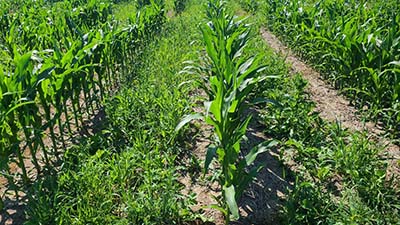Adopting cover crops may lead to increased yields in your main crops as your field's soil is enriched and its biodiversity is naturally supported. The biggest benefit is in the ability to mix and match varieties to solve your specific problems.
With so many options available, how do can you choose what's right for you?
While many cover crops tackle multiple problems, these crops are great starters:
Forage Radish
- With their long taproots, forage radishes penetrate compacted soil, loosening it and "resetting" the soil's structure for subsequent crops. The channels created by the radish's complex root system usually remain open after termination ≥ this improves moisture drainage throughout the soil and allows for easier root infiltration from subsequent crops.
- Additionally, these channels provide excellent access to subsoil moisture, improving the drought resilience of your crops.
- Not only will rapid growth of forage radish out-compete weeds, especially in fall, their canopies do an excellent job of combating soil erosion.
Buckwheat
- Taking no time to establish, this broadleaf cover crop works fast to create a hypercompetitive environment for weeds ≥ suppressing them before they have the chance to germinate.
- While it does its job keeping the soil clear of weeds, its roots take over the topsoil, where they loosen it. Additionally, the roots work to release nutrients like rock phosphate into the soil.
- Buckwheat decomposes as fast as it grows, which means it will quickly add nutrients back into the soil, in time for your crops to absorb
Hairy Vetch
- Its vigorous growth makes it a great tool in early weed suppression. However, its effectiveness will drop while it decomposes, which means you will have to develop a secondary solution for aggressive weeds that resisted the vetch's efforts.
- Beneath the surface, hairy vetch creates a loose topsoil and can improve moisture within the root zone over winter.
- And, like all legumes, hairy vetch is a great source of nitrogen for your soil!
Fall rye/Winter pea
- While it can take a considerable effort to establish two cover crop types ≥ however, fall rye and winter pea pair well together! The rye's tall stalk provides structure for the peas, allowing them to establish their root systems.
- Come spring, your soil will be replenished and ready for your crops. The peas will reintroduce nitrogen to your soil and the rye's deep root system loosens compact soil, promoting a healthy soil structure for your spring crop!
- This dynamic duo can be planted in fall or early winter, even after the first light frost (however you may not want to be planting at this point)
In our cover crop trials, we had lots of good luck establishing fall rye/winter peas on dryland. Additionally, we saw great establishment of hairy vetch and Italian ryegrass under irrigation (note that these two were included in an intercropping trial)!
However, not all cover crops had the same success ≥ clovers had poor establishment as both dryland cover crops and irrigated intercrops due to weed competition and emergence issues. Our forage radish cover crops were unfortunately decimated by flea-beetles - a common issue with the crop, depending on insect forecasts.
Our new, on-going, irrigated cover crop and roller crimping projects saw fantastic establishment from fall rye/winter pea and winter oats.
As with all cover crops, you will want to terminate it before it has a chance to add to the seedbed and sprout volunteers in subsequent years!

